
Deep in the Coronado National Forest lies an untamed location for only the most serious (or foolhardy) of rock collectors. While famous for its fantastic specimens, Miller Canyon in the Huachuca Mountains is equally notorious for its inaccessibility. Getting to the canyon is only the first part. Then you have to hike two miles into the rugged wilderness while climbing from an elevation of 5700 feet to 7300 feet. Once you do that then your problems have just begun, since the location with the fluorescence lies on a steep mountainside in a rather precarious rock slide. But the cuts, scrapes, bruises, and dead-dog-tired muscles are worth it, at least for a rabid collector like me, since this is the best location for fluorescent combos outside of New Jersey—in my opinion anyway. At least 7 fluorescent minerals are found here: Calcite, Willemite, Hydrozincite, Powellite, Sphalerite, Smithsonite, and Aragonite. What makes these pieces special is not only the brightness of most specimens but also the variety of patterns and subtle shades of color when the minerals overlap.

The Huachuca Mountains
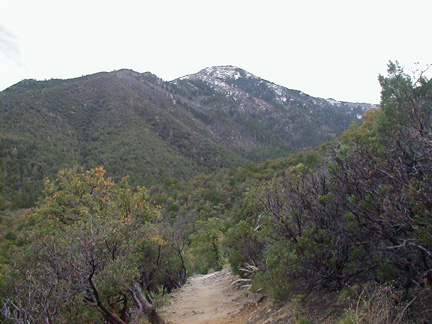
On the path towards Miller Peak
One of the many mine tunnels to be found in the Huachucas
On the slope below the prospect--note the old mining funnel
A view showing the steepness of the tailing slope
Collecting Report June 2011
I was very lucky to have made a trip to the Huachuca Mountains before the Monument fire hit. If I had waited too long then it is likely that I would not have been allowed access to the area. This, perhaps my final collecting trip to Miller Canyon, was different because I didn’t do any actual lamp collecting. Instead, over the period of two long days I made multiple trips up and down the mountain to retrieve specimens that I had previously collected and put aside for later. Out of these I have selected a number of the most interesting pieces including some that are larger than I usually offer. Also included in this lot are some of the rarer combinations with Powellite, Smithsonite, and Sphalerite.
Starting at this point, the prices of the better Miller Canyon specimens will be higher and are likely to continue that way simply because of lack of availability. I have put in my 10 + years of work at this location and so it is time for me to retire, as it were. I hope to take trips out west again and may perhaps visit the mine site on occasion, but that remains simply a hope at this time. If somebody new wants to go up and work the area the way that I used to then perhaps that will keep prices lower.
As always, I kept an eye open for wildlife but the weather was unusually hot and dry, conditions that have made the fire season so bad in Arizona this year. As a result, this trip I just saw mostly deer, squirrels, and the usual numerous Yarrow’s spiny lizards scurrying over rocks and up trees.

Yarrow's Spiny Lizard
Another lizard spotted on this trip was the Madrean alligator lizard. On this specimen you can see that the dorsal pattern ends part-way down the tail, indicating that it was broken and has regenerated.

Madrean Alligator Lizard
A less-common sighting was a group of frogs that jumped into a small pool of water, all that was left of the usual mountain stream due to the dry heat. Although I wasn’t able to verify, these may have been the endangered Chiricahua leopard frog, a species with the unusual behavior of calling while under water.
One creature that I have searched for many times in the Huachuca Mountains is the Sonoran mountain kingsnake. This very secretive reptile has markings similar to a coral snake but is completely harmless. Despite my efforts I never did find a kingsnake in the Huachuca Mountains, but in recent years I was finally able to find them in northern Arizona. Below is a picture of one that I found near Flagstaff.
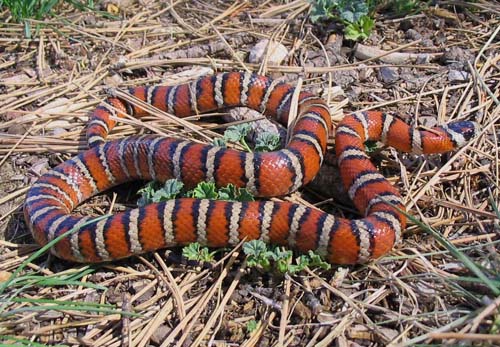
Sonoran Mountain Kingsnake
Collecting Report July 2010
One thing I have noticed in the years that I have been collecting at Miller Canyon is the progress of the flora in reclaiming the area, after a fire burned a large portion of the mountainside some years ago. The following pictures were taken approximately 10 years apart and show some locust and fir trees on the move. It's not an easy comparison since the first picture was taken in the winter, but still you can tell from the relative height of the young trees.
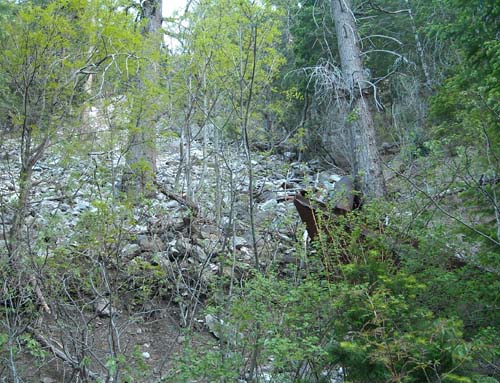
As always, during this trip I kept my eye out for wildlife and made sure to bring my camera along. Before sunset I spotted two large birds soaring overhead and making loud whistling calls. My first guess based on the calls and the silhouette form is that they were golden eagles. However, John Smith suggests that they might been one of the Sonoran province hawks.

My next sighting was a spotted skunk that was foraging at my collecting area after dark. He kept approaching my position while I was resting at the bottom of the mine tailings so I constantly had to chase him off. Later I found out what he was looking for when I returned back to my resting spot to find all of my pretzels gone and my bag of beef jerky full of teeth marks.
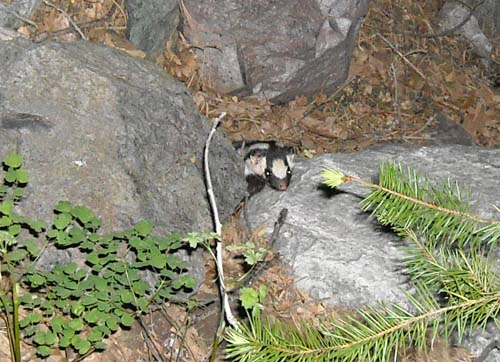
My last sighting was a bear in the canyon when I was coming down in the morning. I was a pretty safe distance up on the trail above the canyon bottom so I approached closer to his position to get a good picture. Then two things went wrong. First, my camera battery ran out. Second, when I got to the right spot I found that the bear was already climbing the canyon straight for me, so I backed off a hundred feet or so. Once on the trail the bear spotted me and immediately high-tailed it further up the canyon wall at great speed. When they say that you can't outrun a bear they aren't kidding.
The collecting was excellent this time and I found a number of pieces with the more rare minerals: smithsonite, powellite, and sphalerite. This trip was also unusual in that I brought back some very large pieces including a sphalerite combination that is probably the biggest (and most expensive) Miller Canyon piece that I have ever offered.
Collecting Report, July 2009
In July I returned to Miller Canyon for my first collecting trip there in quite a while. One thing I have noticed over the years is increasing human encroachment. Being designated as a wilderness area has eliminated vehicle traffic but certainly not foot traffic. This year for the first time I have found evidence (stash bags, etc.) that drug smugglers have begun to use the mining site as a hideout. The mine is literally off the beaten path so not very many people go there. There is a small hidden trail that veers off to the side from the main trail and you have to go through numerous switchbacks to make it to the site. In the past the smugglers have used a few spots off that side path as hiding places, but this is the first time that they have made it all of the way back to the mine itself.
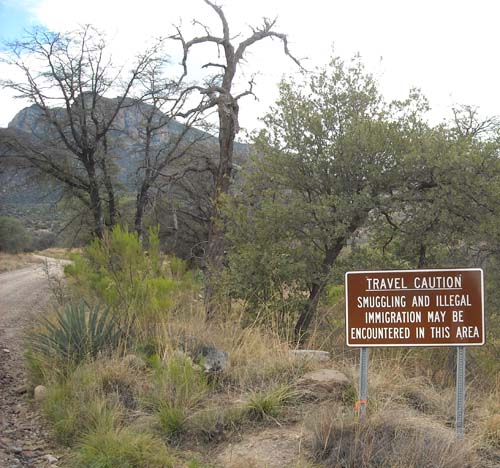
A warning sign on the way to Miller Canyon
In July the monsoon season is in full swing so I expected some wildlife sightings and brought along my camera but the only thing I captured on film was an owl at dusk. My friend John Smith says that this looks likely to be a spotted owl based on the picture, estimated size, and a description of its call. Later I found a scorpion while I was digging through the rocks. The scorpions that live up in the mountains of Arizona are small and dark brown. They are less brightly fluorescent than the several desert varieties found in Arizona, probably because of the dark pigment. On the way back down the canyon early in the morning I heard many exotic sounding bird calls but didn’t spot any of them.

As usual I set up a base and ventured out to the rock slides to search for fluorescent treasures. That worked fine for a couple of hours but then the monsoon clouds rolled in at about midnight and dumped rain on the whole area. My only recourse was to quickly gather my stuff and to hide under the old ore funnel at the bottom of the slope until the rain ended after about a half hour. That wasn’t so bad but then it happened again two hours later, forcing me to take shelter once more.
Collecting was difficult this time. In years past quality specimens just seemed to pop out of the ground but I had to really work hard to find much that was decent this time. B-grade material is still in abundance but it’s getting harder and harder to find the truly great pieces. My goals for the past several trips have been to find the less-usual minerals, Powellite, Smithsonite, and Sphalerite. This trip yielded a decent number of Powellite pieces, less Smithsonite, but nothing at all of Sphalerite, not a single piece!
Collecting Report, September 2007
My wife Barbara had a conference at the Biosphere facility north of Tucson so I took the opportunity to do a short collecting trip that evening. We drove out of Flagstaff in the morning, I dropped her off at the Biosphere in the afternoon, then I went and collected rocks all night. My haul wasn't quite as spectacular as the previous trip, less Sphalerite for one thing, but there are plenty of nice pieces.
This time I didn't happen upon any smugglers but found a lot of other mountain creatures. A weather front was going through that evening and strong winds whipped up the canyon. Perhaps it was the change in atmospheric pressure but there were more animals active than I had ever seen there before. In the abandoned mine tunnel (shown above) there were two bats hanging around. That time of night they would usually be flying in search of insects but perhaps the wind was suppressing their activities. At one spot I heard a group of three owls calling back and forth to each other. Not far from there I caught a glimpse of something walking around. It was hard to see but I could tell that it had a long tail with black bands. My first thought was that it might be a ringtail but I finally concluded that it was a coatimundi. Rarely seen, these only occur in the United States along the border with Mexico. Lastly, I was lucky to spot a large blacktail rattlesnake crossing the path, lucky I didn't step on him, that is. It was a magnificent specimen and calmly went on his way across the path while I waited a safe distance back. Unfortunately I didn't have a camera with me but below is a picture of another blacktail that I found in the Huachucas previously. In the picture you can clearly see how the blacktail it got its name.
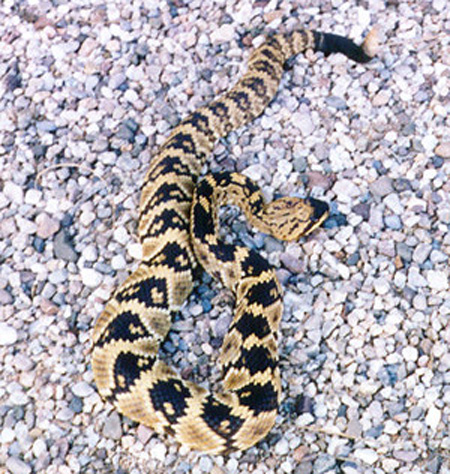
Collecting Report, July 2007
Because of the cost as well as the wear and tear on the body I have adopted a philosophy of taking the extra time to search for only the best and most unusual specimens. I came back with many surprises, for one thing several pieces with unexpected Sphalerite content. There are also a lot of small pieces that were just too good to leave behind. There is a restriction on how much weight I can bring down the mountain on each trip since the load has to be carried on foot. Because the prospect is in the middle of a designated wilderness area no vehicles of any kind are allowed.
Day 1:
When I arrived at the parking area at 5 pm it was over 100 degrees at an elevation of 5700 feet and I was going to have to hike up to 7300 feet. I headed up a little more slowly than usual, trying not to wear myself out. After all, I was going to have to do this two nights in a row.
About two and a half hours later I arrived at the mine site and rested while it got dark. The area looked more or less the same as it always has, except that it has become a little more overgrown than before. A lot of the underbrush was removed when a fire swept through there some years ago but now it is coming back.
About 11 pm while searching I heard a buzzing sound and was startled to find a medium-sized banded rock rattlesnake hiding in the rocks. I had never been concerned about that before, mainly because the slope is north-facing and, being ectotherms, I figured there wouldn’t be any snakes living there. I guess I was wrong about that...
Because of the heat I ran out of water sooner that I had planned and was forced to come down around midnight. When I made it back to the car I still had a couple hours of darkness left so I headed east to search for some Bisbee Sphalerite. Bisbee has been closed to collecting for many years but I got information on where to go outside of town to search for specimens of the fantastic Sphalerite that was mined there. It’s not easy work, usually hours of searching to come up with a few rather small specimens. This time I was lucky enough to find one good sized piece as well as some nice smaller ones.
Day 2:
I learned my lesson the day before and waited until things cooled off a bit before starting the long hike. On the way up the canyon at about 10 pm I startled someone camping in a tent just off the trail. This was also very startling for me because it was near a known hideout for drug smugglers. The Miller Canyon trail for the past several years has become a drug corridor because it starts close to the border, bypasses the roads, and empties into a residential area south of Sierra Vista. It has gotten bad enough that they have posted a sign on Miller Canyon Road warning to be careful of such activity. Several times I have been mistaken for a drug runner and have been stopped at gunpoint and asked to show the contents of my backpack. That’s bad enough but at least it was the good guys with the guns in that case. I’d hate to find out what it’s like to meet up with an armed smuggler in the middle of the night, and that’s what made the encounter with the guy in the tent upsetting. When he heard me he got up started shining his light around. At that point I turned off my flashlight and froze in my tracks. Fortunately he was unable to spot me and after a while went back inside the tent. After waiting several minutes I slowly and carefully made my way up the trail without the aid of a flashlight until I was well out of sight. The next morning he was gone.
After arriving at the mine site I got to work but was almost immediately pummeled by a monsoon thunderstorm. I had run the gamut from 115 degrees while passing through Phoenix and Tucson to what seemed like about 60 degrees, and soaking wet at that. Determining that it would be a bad idea to work in the rain with my lamp on I retired under a rock overhang and shivered for about 1 1/2 hours. After the rain finally let up I got back to work and accomplished as much as I could until sunrise at about 5 am.